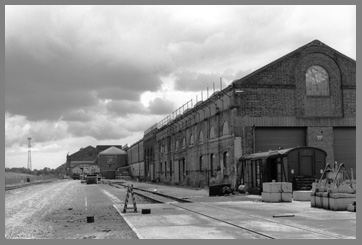Lectures
6th February 2013: History of Ashford Railway Works 1847-1981

Mr Young's detailed and well illustrated lecture was something of a personal journey; he was one of the 4th generation of his family to work at Ashford Railway Works (ARW). He served 41 years with BR, beginning as a locomotive fitter at 16 years old, and his great grandfather was at the works in 1854. A journey also through the growth and decline of a great enterprise; ARW epitomises the arrival of engineering and industry in the Victorian era, coming to define the town in employment and social terms. When Mr Young started work ARW employed 2000 people; his grandfather has played in a cup winning Ashford United football team bolstered by the works, and South Ashford Church was the 'railway church'. Newtown Estate was a planned railway workers housing development including a pub and a bathhouse which (converted) still survives.
The story began in 1846 when the Directors of South Eastern Railway bought 185 acres at Ashford to build a 'Locomotive Establishment'. Growth was rapid and by 1851 ARW was supporting some 3,000 people if employees' wives and children are included. Amalgamations at the close of the century and then in the 20ies saw SER become first part of South Eastern and Chatham then Southern Railway. The works went through the Victorian and Edwardian eras (Clive Young's grandfather travelling on the royal trains with both monarchs), and the first and second world wars (a bomb nearly hit his father's office, and the works raised money to pay for a Spitfire). Beyond the era of nationalisation of the railways in 1948 and up to the 1961 Beeching closures ARW was building steam, diesel and electric locomotives. The locomotive workshops closed in 1962 and the wagon works continued for a further two decades until closure. The last steam locomotive to be built at ARW is now in York Railway Museum - a matter of regret for Mr Young that Ashford for all its railway history cannot host it.
Clive Young described and showed the many activities and workshops; foundry, heavy machine shop, boiler shop, blacksmiths shop (which would knock up a tool of your choice to order), wheel shop, erecting shop... There was a metallurgy lab, a conference room, a training school. Not a place for the timid - presses, slotters, lathes, cranes, belts, pulleys, chains, and red hot rivets tossed from one side of a workshop floor to the other, to be caught and punched home. Health and safety? Men aloft on cross girders, working with unguarded pulleys and live electric cables, black as sweeps after cleaning out a smoke box - hardly! And a strict regime - long days, clock in and clock off, and woe betide you if you went round to the manager's side of his desk without permission. Yet there were glimpses of a life made tolerable, in a world gone by, of security and comradeship. A photo of (dozens of) workers proudly standing around and draped over a locomotive; hot toast made on a coke stove on a cold day. And employment, for life, and for your children if they chose.
Paul Cobb
Photograph © Steaming around Britain's Railways

